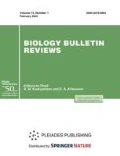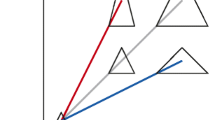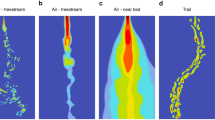Abstract
Sharp intensification of the protective function of the fore wing in Coleoptera has made their flight apparatus posteromotoric and initiated the development of an apparatus for folding the hind wings beneath the elytra. This could hardly take place without a higher deformability of veins relative to each other, which diminished the strength properties of the wing support. The effect has been stressed by the presence of folds. The wing support and folding pattern evolved as interrelated: the former evolved to be more flexible, with no or minimum loss of rigidity; the latter evolved to be less harmful for the supporting structures. The only function performed, as well as simple structure and low specialization of folds made the folding pattern highly labile in the course of evolution. It evolved superior to wing venation, thus defining many transformations of the latter. This evolutionary conservatism of wing venation stemmed from the fact that many veins performed two conflicting functions. For this conflict to be resolved an adaptive compromise was needed, which brought the wing to orthogenetic development. The main evolutionary trends in wing venation and the folding pattern were those towards simplification and higher complexity, respectively. The coleopteran wing has passed two main evolutionary stages. The major evolutionary factors were wing posteromotorism at the first stage of evolution, with a trend toward miniaturization at the second stage. Each stage resulted in the development of a particular wing type, archostematan and “cantharoid”, respectively. They differ fundamentally. In the wing of the former type, the folding and flight apparatus constitute a steady coadaptive ensemble, because their supporting systems overlap considerably. This wing remained stable through evolution, and its structural variations were only minor deviations from the ground plan. The development of the “cantharoid” wing type was an upgrade of the morphofunctional organization. The region of maximum transverse deformations initiated by folding was extruded bayond the basal, supporting, part of the remigium, which contributed much to rigid properties of the chief supporting axes. The two wing apparatus have become more autonomous after acquiring the above structure. This expanded the range of possible specialization and gave rise to a great variety of derived wing types.
Similar content being viewed by others
References
Alexander, R., Animal Mechanics, London: Sidgwick & Jackson, 1968.
Blum, P., Zur Phylogenie und Ökologischen Bedeutung der Elytrenreduktion und Abdomenbeweglichkeit der Staphylinidae (Coleoptera). Vergleichend- und funktionsmorphologische Untersuchungen, Zool. Jb. Anat., 1979, vol. 102, no. 4, pp. 533–582.
Brackenbury, J.H., Wing folding and free-flight kinematics in Coleoptera (Insecta): a comparative study, J. Zool., London, 1994, vol. 232, part 2, pp. 253–283.
Brodskii, A.K., Evolution of wing apparatus of stoneflies (Plecoptera). III. Deformation of the wings of Isogenus nubecula Newm. during flying, Entomol. Obozr., 1981, vol. 60, no. 3, pp. 523–534.
Brodskii, A.K., Evolution of wing apparatus of stoneflies (Plecoptera). IV. Kinematics of the wings and conclusions, Entomol. Obozr., 1982, vol. 61, no. 3, pp. 491–500.
Brodskii, A.K., Mechanika poleta nasekomykh i evolyutsiya ikh krylovogo apparata (Mechanics of the Insect’s Flying and Evolution of the Wing Apparatus), Leningrad: Leningr. Gos. Univ., 1988.
Crowson, R.A., The Natural Classification of the Families of Coleoptera, London: N. Lloyd & Co., 1955.
Crowson, R.A., The evolutionary history of Coleoptera, as documented by fossil and comparative evidence, in Atti del Congresso Nazionale Italiano di Entomologia, Sassari, Maggio 20–25, 1974, Firenze, Italy, 1975, pp. 47–90.
Fedorenko, D.N., Evolution of the Beetle Hind Wing with Special Reference to Folding (Insecta, Coleoptera), Sofia: Pensoft., 2009.
Forbes, W.T.M., The wing-venation of the Coleoptera, Ann. Entomol. Soc. Am., 1922, vol. 15, no. 4, pp. 328–345.
Forbes, W.T.M., The wing folding patterns of the Coleoptera, J. N.Y. Entomol. Soc., 1926, vol. 34, no. 1, pp. 42–68; no. 2, pp. 912–139.
Grodnitsky, D.L., Adaptation of the distinct-stage insects to flapping motion, Zool. Zh., 1996, vol. 75, no. 5, pp. 692–700.
Grodnitsky, D.L. and Morozov, P.P., Morphology, flight kinematics and deformation of the wings in holometabolan insects (Insecta: Oligoneoptera + Scarabaeiformes), Russ. Entomol. J., 1994, vol. 3, nos. 3–4, pp. 3–32.
Haas, F., Geometrie, Mechanik und Evolution der Flugelfaltung bei den Coleoptera (Insecta), PhD Thesis, Jena, 1998.
Haas, F. and Beutel, R.G., Wing folding and the functional morphology of the wing base in Coleoptera, Zoology, 2001, vol. 104, pp. 123–141.
Haas, F., Gorb, S., and Blikhan, R., The function of resilin in beetle wings, Proc. R. Soc. Lond. B, 2000, vol. 267, pp. 1375–1381.
Haas, F. and Kukalová-Peck, J., Dermaptera hind-wing structure and folding: new evidence for familial, ordinal, and superordinal relationships within Neoptera (Insecta), Eur. J. Entomol., 2001, vol. 98, pp. 445–509.
Haas, F. and Wootton, R.J., Two basic mechanisms in insect wing folding, Proc. R. Soc. Lond. B, 1996, vol. 263, pp. 1651–1658.
Hammond, P.M., Wing-folding mechanisms of beetles, with special reference to investigations of adephagan phylogeny, in Carabid Beetles: Their Evolution, Natural History, and Classification, Erwin, T.L., Ball, G.E., Whitehead, D.R., and Halpern, A.L., Eds., The Hague: W. Junk, 1979, pp. 113–180.
Heberdey, R.F., Beiträge zum Bau des Subelytralraumes und zur Atmung der Coleopteren, Z. Morphol. Ökol. Tiere, 1938, vol. 33, pp. 667–734.
Kukalová-Peck, J., Fossil history and evolution of hexapod structures, in CSIRO, Insects of Australia. A Textbook for Students and Research Workers, 2nd ed., Carlton: Melbourne Univ. Press, 1991, vol. 1, pp. 141–179.
Kukalová-Peck, J. and Lawrence, J.F., Evolution of the hind wing in Coleoptera, Can. Entomol., 1993, vol. 125, pp. 181–258.
Kukalová-Peck, J. and Lawrence, J.F., Relationships among coleopteran suborders and major endoneopteran lineages: evidence from hind wing characters, Eur. J. Entomol., 2004, vol. 101, pp. 95–144.
Lawrence, J.F. and Newton, A.F., Jr., Families and subfamilies of Coleoptera (with selected genera, notes, references and data on family-group names), in Biology, Phylogeny and Classification of Coleoptera: Papers Celebrating the 80th Birthday of R.A. Crowson, Pakaluk, J. and Ślipiński, S.A., Eds., Warszawa: Muz. Inst. Zool., Pol. Acad. Nauk, 1995, pp. 779–1006.
Lawrence, J.F., Ślipiński, S.A., and Pakaluk, J., From Latreille to Crowson: a history of the higher-level classification of beetles, in Biology, Phylogeny and Classification of Coleoptera: Papers Celebrating the 80th Birthday of R.A. Crowson, Pakaluk, J. and Ślipiński, S.A., Eds., Warszawa: Muz. Inst. Zool., Pol. Acad. Nauk, 1995, pp. 87–154.
Lyubarskii, G.Yu., Arkhetip, stil’ i rang v biologicheskoi sistematike (Archetype, Style, and Range in Biological Systematics), Moscow: KMK, 1996.
Magnan, A., La Locomotion Chez les Animaux, 1. Le Vol des Insects, Paris: Herman & Co., 1934.
Marden, J.H., Maximum lift production during takeoff in flying animals, J. Exp. Biol., 1987, vol. 130, pp. 235–258.
Meien, S.V., Major aspects of typology of the organisms, Zh. Obshch. Biol., 1978, vol. 39, no. 4, pp. 495–508.
Ponomarenko, A.G., Division of Coleoptera to suborders, in Chteniya pamyati N.A. Kholodkovskogo “Voprosy paleontologii nasekomykh” (Readings Dedicated to the Memory of N.A. Kholodkovskii “Paleontology of the Insects”), Leningrad: Nauka, 1973, pp. 78–89.
Rasnitsyn, A.P., Origin and evolution of lower Hymenoptera, Tr. Paleontol. Inst. Akad. Nauk SSSR, 1969, vol. 123, pp. 1–196.
Rasnitsyn, A.P., Inadaptation and evadaptation, Paleontol. Zh., 1986, no. 1, pp. 3–7.
Rasnitsyn, A.P., Evolution rate and theory: hypothesis of adaptive compromise, in Evolyutsiya i biotsenoticheskie krizisy (Evolution and Biocenotic Crisis), Moscow: Nauka, 1987, pp. 46–63.
Schmalhausen, I.I., Regulyatsiya formoobrazovaniya v individual’nom razvitii (Regulation of Specification in Individual Development), Moscow: Nauka, 1964.
Schmalhausen, I.I., Organizm kak tseloe v individual’nom i istoricheskom razvitii (Organism as the Whole in Individual and Historical Development), Moscow: Nauka, 1982.
Schneider, P., Die Flugtypen der Käfer (Coleoptera), Entomol. German., 1975, vol. 1, nos. 3–4, pp. 222–231.
Schneider, P., Die Flug- und Faltungstypen der Käfer (Coleoptera)., Zool. Jb., Anat., 1978, vol. 99, no. 2, pp. 174–210.
Schneider, P., Flugverhalten und Stoffwechsel des Südafrikanischen Fruchtkäfers Pachnoda sinuate, Heidelberg: Wissenschaftliche Filme aus Heidelberg, 1997.
Vogel, S., Flight in Drosophila. II. Variation in stroke parameters and wing contour, J. Exp. Biol., 1967, vol. 46, no. 2, pp. 383–392.
Wallace, F.L. and Fox, R.C., A comparative morphological study of the hind wing venation of the order Coleoptera, part I, Proc. Entomol. Soc. Washington, 1975, vol. 77, no. 3, pp. 329–354.
Wallace, F.L. and Fox, R.C., A comparative morphological study of the hind wing venation of the order Coleoptera, II, Proc. Entomol. Soc. Washington, 1980, vol. 82, no. 4, pp. 609–654.
Weis-Fogh, T., Quick estimates of flight fitness in hovering animals, including novel mechanisms for lift production, J. Exp. Biol., 1973, vol. 59, no. 1, pp. 169–230.
Author information
Authors and Affiliations
Corresponding author
Additional information
Original Russian Text © D.N. Fedorenko, 2013, published in Zhurnal Obshchei Biologii, 2013, Vol. 74, No. 6, pp. 472–487.
Rights and permissions
About this article
Cite this article
Fedorenko, D.N. Transverse folding and evolution of the hind wings in beetles (Insecta, Coleoptera). Biol Bull Rev 5, 71–84 (2015). https://doi.org/10.1134/S2079086415010028
Received:
Published:
Issue Date:
DOI: https://doi.org/10.1134/S2079086415010028




